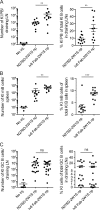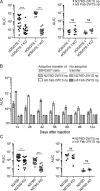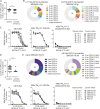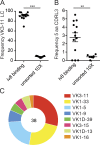Anti-idiotypic antibodies elicit anti-HIV-1-specific B cell responses
- PMID: 31345931
- PMCID: PMC6780999
- DOI: 10.1084/jem.20190446
Anti-idiotypic antibodies elicit anti-HIV-1-specific B cell responses
Abstract
Human anti-HIV-1 broadly neutralizing antibodies (bNAbs) protect against infection in animal models. However, bNAbs have not been elicited by vaccination in diverse wild-type animals or humans, in part because B cells expressing the precursors of these antibodies do not recognize most HIV-1 envelopes (Envs). Immunogens have been designed that activate these B cell precursors in vivo, but they also activate competing off-target responses. Here we report on a complementary approach to expand specific B cells using an anti-idiotypic antibody, iv8, that selects for naive human B cells expressing immunoglobulin light chains with 5-amino acid complementarity determining region 3s, a key feature of anti-CD4 binding site (CD4bs)-specific VRC01-class antibodies. In mice, iv8 induced target cells to expand and mature in the context of a polyclonal immune system and produced serologic responses targeting the CD4bs on Env. In summary, the results demonstrate that an anti-idiotypic antibody can specifically recognize and expand rare B cells that express VRC01-class antibodies against HIV-1.
© 2019 Dosenovic et al.
Figures








Similar articles
-
Diverse recombinant HIV-1 Envs fail to activate B cells expressing the germline B cell receptors of the broadly neutralizing anti-HIV-1 antibodies PG9 and 447-52D.J Virol. 2014 Mar;88(5):2645-57. doi: 10.1128/JVI.03228-13. Epub 2013 Dec 18. J Virol. 2014. PMID: 24352455 Free PMC article.
-
Recombinant HIV envelope proteins fail to engage germline versions of anti-CD4bs bNAbs.PLoS Pathog. 2013 Jan;9(1):e1003106. doi: 10.1371/journal.ppat.1003106. Epub 2013 Jan 3. PLoS Pathog. 2013. PMID: 23300456 Free PMC article.
-
9G4 autoreactivity is increased in HIV-infected patients and correlates with HIV broadly neutralizing serum activity.PLoS One. 2012;7(4):e35356. doi: 10.1371/journal.pone.0035356. Epub 2012 Apr 18. PLoS One. 2012. PMID: 22530008 Free PMC article.
-
Targeting broadly neutralizing antibody precursors: a naïve approach to vaccine design.Curr Opin HIV AIDS. 2019 Jul;14(4):294-301. doi: 10.1097/COH.0000000000000548. Curr Opin HIV AIDS. 2019. PMID: 30946041 Review.
-
On the benefits of sin: can greater understanding of the 1F7-idiotypic repertoire freeze enhance HIV vaccine development?Hum Vaccin Immunother. 2013 Jul;9(7):1532-8. doi: 10.4161/hv.24460. Epub 2013 Apr 9. Hum Vaccin Immunother. 2013. PMID: 23571168 Review.
Cited by
-
Anti-idiotype isolation of a broad and potent influenza A virus-neutralizing human antibody.Front Immunol. 2024 May 30;15:1399960. doi: 10.3389/fimmu.2024.1399960. eCollection 2024. Front Immunol. 2024. PMID: 38873606 Free PMC article.
-
High-Throughput Mapping of B Cell Receptor Sequences to Antigen Specificity.Cell. 2019 Dec 12;179(7):1636-1646.e15. doi: 10.1016/j.cell.2019.11.003. Epub 2019 Nov 28. Cell. 2019. PMID: 31787378 Free PMC article.
-
The HIV-1 envelope glycoprotein: structure, function and interactions with neutralizing antibodies.Nat Rev Microbiol. 2025 Jul 23. doi: 10.1038/s41579-025-01206-6. Online ahead of print. Nat Rev Microbiol. 2025. PMID: 40702326 Review.
-
HIV-1 CD4-binding site germline antibody-Env structures inform vaccine design.Nat Commun. 2022 Oct 17;13(1):6123. doi: 10.1038/s41467-022-33860-2. Nat Commun. 2022. PMID: 36253376 Free PMC article.
-
Mathematical modeling to reveal breakthrough mechanisms in the HIV Antibody Mediated Prevention (AMP) trials.PLoS Comput Biol. 2020 Feb 21;16(2):e1007626. doi: 10.1371/journal.pcbi.1007626. eCollection 2020 Feb. PLoS Comput Biol. 2020. PMID: 32084132 Free PMC article.
References
-
- Abbott R.K., Lee J.H., Menis S., Skog P., Rossi M., Ota T., Kulp D.W., Bhullar D., Kalyuzhniy O., Havenar-Daughton C., et al. . 2018. Precursor Frequency and Affinity Determine B Cell Competitive Fitness in Germinal Centers, Tested with Germline-Targeting HIV Vaccine Immunogens. Immunity. 48:133–146.e6. 10.1016/j.immuni.2017.11.023 - DOI - PMC - PubMed
-
- Adams P.D., Afonine P.V., Bunkóczi G., Chen V.B., Davis I.W., Echols N., Headd J.J., Hung L.W., Kapral G.J., Grosse-Kunstleve R.W., et al. . 2010. PHENIX: a comprehensive Python-based system for macromolecular structure solution. Acta Crystallogr. D Biol. Crystallogr. 66:213–221. 10.1107/S0907444909052925 - DOI - PMC - PubMed
-
- Alam S.M., Aussedat B., Vohra Y., Meyerhoff R.R., Cale E.M., Walkowicz W.E., Radakovich N.A., Anasti K., Armand L., Parks R., et al. . 2017. Mimicry of an HIV broadly neutralizing antibody epitope with a synthetic glycopeptide. Sci. Transl. Med. 9:eaai7521 10.1126/scitranslmed.aai7521 - DOI - PMC - PubMed
-
- Andrabi R., Voss J.E., Liang C.H., Briney B., McCoy L.E., Wu C.Y., Wong C.H., Poignard P., and Burton D.R.. 2015. Identification of Common Features in Prototype Broadly Neutralizing Antibodies to HIV Envelope V2 Apex to Facilitate Vaccine Design. Immunity. 43:959–973. 10.1016/j.immuni.2015.10.014 - DOI - PMC - PubMed
Publication types
MeSH terms
Substances
Associated data
- Actions
- Actions
- Actions
Grants and funding
LinkOut - more resources
Full Text Sources
Other Literature Sources
Medical
Molecular Biology Databases
Research Materials

